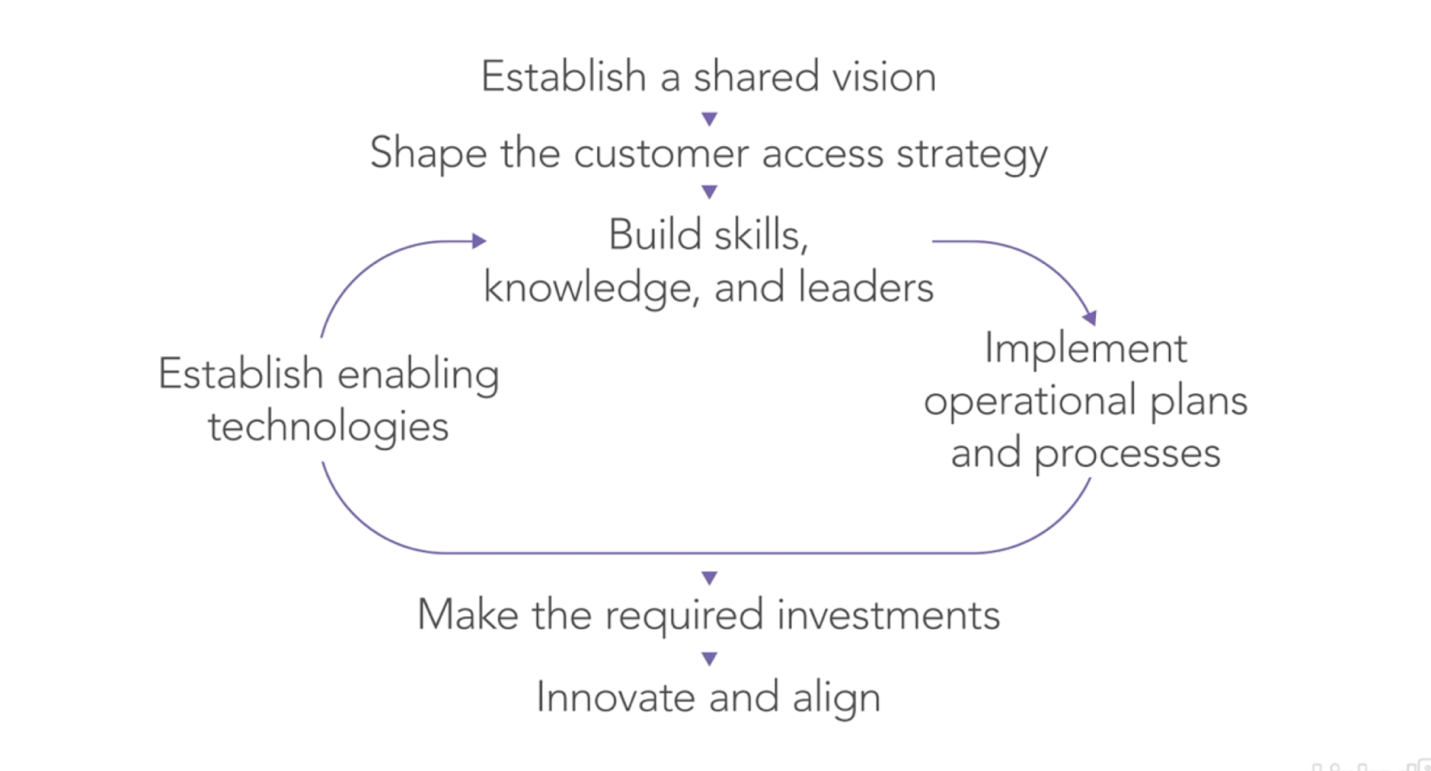Is your approach to customer service headed in the right direction? How do you maximize the value of customer service? Your contact center? How and where do you best leverage the potential of new capabilities powered by artificial intelligence?
These are important questions, and you will discover the answers as you put an effective customer service strategy in place. Here's a model you can use for developing your strategy. It's simple, effective, and includes just seven components, steps you'll go through as you define your organization's strategy.

The first step is to define your vision for customer service. Where do you want to go? Vision can take many forms, including a vision statement, a mission statement, a set of values, or some overarching principles or standards.
As an example, I love REI's mission, which also serves as its customer service vision: "We inspire, educate, and outfit for a lifetime of outdoor adventure and stewardship." USAA, the highly-rating insurance and financial company, operates around four core values: Service. Loyalty. Honesty. Integrity. And yes, they discuss and think about them in any decision.&
The next step is to shape your customer access strategy. You probably already have one, whether it's been documented or not. It includes who your customers are, the channels through which you provide service (web, phone, text, in-person, and others), your hours of operation, and others.
Your customer access strategy should include these 10 elements:
- Customer segments;
- Types of Interactions;
- Access channels;
- Hours of operation;
- Objectives for accessibility;
- Routing;
- Required resources;
- Required information;
- Analysis/improvement; and
- Guidelines for new services.
The question is, does your customer access strategy effectively support your overall customer service strategy. Does it need a tune-up?
The next steps are best considered together and are each part of what I like to call the big three: people, processes, and technology. Here, you put definition around how your organization is going to do the following:
- Build the skills, knowledge, and leaders you need to deliver the service you envision.
- Implement operational plans and processes that support your strategy.
- Establish enabling technologies.
Next, you can put a pencil to budget and identify the investments that support your strategy. You have to know where you want to go before defining the budget. Flying from Chicago to London will have different requirements than a short hop to Nashville.
The final step is to innovate and align. This last component is key to sustaining success. It's where you'll review your strategy and the priorities, the initiatives, that make sense. It takes you right back to the top where you revisit vision, customer access strategy, the big three, and investments you are making.
As you build out the steps of this framework and weave them into discussions and planning, you'll be encouraging the rest of your team to do the same. You'll make decisions that are much better aligned. And that's a big part of what strategy is ultimately about—making good decisions that are aligned and that support your customer service vision.
Keeping Strategy Current
Not having a sound strategy is an obvious opportunity. But I've found that many organiztions have—sort of, kind of—a strategy that is guiding direction. The problem in many cases is that it's out of date or perceived that way. Decisions become fragmented and results begin to suffer.
Here are five steps that will help keep your strategy alive and vibrant:
One is to assign an owner who is responsible for seeing that strategy is getting the regular review and attention it needs. This person or group will make sure that a representative team reviews and, if necessary, updates your service strategy at least a couple of times a year.
Second, ensure that the strategy is understood. Some leaders view strategy as a competitive secret. And while your team should treat and guard it carefully, just like other inside information, strategy has to be broadly understood to really impact day-to-day decisions. (And frankly, the strategies of the most successful organizations become pretty obvious anyway.)
Third, be sure to keep the format simple and inspiring. It should be helpful in guiding the myriad of decisions that are made at the operational level every day. If it's too complex or runs for pages and pages, it's probably not going to be easily understood and used. That will undermine its effectiveness.
The fourth step is to be an example yourself. Refer to strategy often as you make decisions. Just recognizing the importance of strategy through your actions goes a long way to inculcating it into the culture. Others around you will begin to do the same.
Finally, consider introducing your strategy to new employees as a part of their initial onboarding and training. Some organizations even present strategy to prospective employees, both to give them a sense of what they will be part of and to see how well they resonate with your direction. Do they seem to get excited about it?<
When author Jim Collins talks about strong and lasting companies, he says, "Greatness is not a matter of circumstance; it is a matter of choice and discipline."
I agree. Developing and using an effective customer service strategy is an important discipline and one that can profoundly set your organization apart.
Brad Cleveland, a consultant and speaker, is senior advisor and former CEO of the International Customer Management Institute (ICMI).